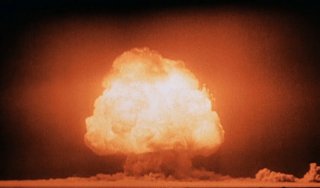Great Britain was Prepared to Stop a Soviet Invasion at Any Cost
Soviet tanks may have rolled across Europe, but wouldn't have driven into Great Britain.
Here's What You Need To Remember: In the event of a Soviet invasion, tunnels and bridges all over Europe would have been blown up. But the Chunnel is a railroad tunnel thirty-one miles long (the underwater portion alone is 23.5 miles), leading to fears that conventional explosives wouldn’t be enough.
If Soviet tanks ever blitzed across western Europe to the shores of the English Channel, the English had a secret plan to keep them from crossing into Britain.
Blow up the Channel Tunnel with a nuclear bomb.
This nuclear Brexit would have kept the “barbarians from the gates of Calais,” in the words of one British official during the Cold War, according to the newspaper the Independent, which found the plan buried in a government archive. The bomb would also would have devastated the coasts of England and France, making it a “Better Dead than Red” defense.
The bomb idea first surfaced in 1959, when the Channel Tunnel (“Chunnel”) was proposed as a means of connecting Britain with the European mainland. The very idea set off alarm bells among British officials. For centuries, the channel has been Britain’s natural barrier, the moat that kept the armies of Napoleon and Hitler (as well as immigrants and refugees today) at bay.
In the event of a Soviet invasion, tunnels and bridges all over Europe would have been blown up. But the Chunnel is a railroad tunnel thirty-one miles long (the underwater portion alone is 23.5 miles), leading to fears that conventional explosives wouldn’t be enough.
“The problem here is that according to Channel Tunnel Group engineers, the tunnel would be virtually unscathed by an explosion of very great magnitude since the force of the explosion would be dissipated along the tunnel,” a defense official told a committee pondering the issue in 1974.
Nuclear explosives would do the trick. However, there was just one problem with detonating a nuclear charge inside a long, narrow tunnel: “An atomic explosion in the tunnel could have a ‘mortar’ effect and cause widespread damage at the portals [of the tunnel] and in the surrounding area.”
Hence the planning committee agreed that it was best not to inform the French that their territory would be nuked. Some British officials also wondered whether the whole idea was pointless: if the Soviet Army could reach Calais without triggering thermonuclear war, then Britain was going to be conquered anyway (presumably the French would have surrendered already).
The Channel Tunnel project was temporarily shelved in the mid-1970s, and that’s when the bomb idea seems to have died. Less drastic alternatives were proposed, such as flooding the tunnel, or blocking it by crashing trains head-on.
Construction of the Channel Tunnel didn’t begin until 1988. The irony, of course, is that it wasn’t until 1994 that the Chunnel was finished. And by then, so was the Soviet Union. Putin may the new bogeyman of Europe, but the only way that Russian tanks will end up in Calais is in a museum.
Yet it would have been more surprising if Britain hadn’t planned to blow up the Channel Tunnel. The British—geographically a part of Europe, except in their own minds—have always been sensitive about invasion across the Straits of Dover (here’s a wishful French drawing of Napoleon’s armies crossing the channel by balloon and tunnel).
The idea for a tunnel across the channel was proposed by a French engineer in 1802, and one reason it went nowhere for nearly three centuries was fear that the structure would become an invasion route. In 1914, Winston Churchill even suggested that the tunnel terminate with a drawbridge that could be lifted to keep French invaders out—note, by the way, that France and Britain were friends at the time.
Perhaps there are still plans somewhere to destroy the Chunnel. Perhaps they are not even needed. Pity the poor army that has cross a thirty-one-mile tunnel 380 feet below sea level, and never knowing whether the walls will come tumbling down and the water rushing in.
Images of Pharaoh’s army drowning in the middle of the Red Sea come to mind.
Michael Peck is a contributing writer for the National Interest. He can be found on Twitter and Facebook. This article first appeared several years ago.
Image: Wikipedia.

